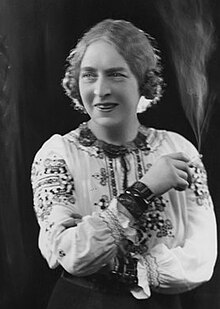Laura Knight | |
|---|---|
 Dame Laura Knight in 1936 | |
| Born | Laura Johnson 4 August 1877 Long Eaton, Derbyshire, England |
| Died | 7 July 1970 (aged 92) London, England |
| Education | Nottingham School of Art |
| Known for | Painting |
| Notable work | The Nuremberg Trial (1946) |
| Movement | Realism, Impressionism |
| Spouse | |
| Awards | Silver Medal at the 1928 Amsterdam Art Olympics |
| Website | www |
Dame Laura Knight DBE RA RWS (née Johnson; 4 August 1877 – 7 July 1970[1]) was an English artist who worked in oils, watercolours, etching, engraving and drypoint. Knight was a painter in the figurative, realist tradition, who embraced English Impressionism. In her long career, Knight was among the most successful and popular painters in Britain. Her success in the male-dominated British art establishment paved the way for greater status and recognition for female artists.[2]
In 1929 she was created a Dame, and in 1936 became the third woman elected to full membership of the Royal Academy.[3] Her large retrospective exhibition at the Royal Academy in 1965 was the first for a woman. Knight was known for painting amidst the world of the theatre and ballet in London, and for being a war artist during the Second World War. She was also greatly interested in, and inspired by, marginalised communities and individuals, including Romani people and circus performers.[2][4]
- ^ Cite error: The named reference
ODNBlkwas invoked but never defined (see the help page). - ^ a b Rosie Broadley (2013). Laura Knight Portraits. National Portrait Gallery, London. ISBN 978-1-85514-463-7.
- ^ The first was Annie Swynnerton, who was elected to full membership in 1922, although shortly afterwards her membership status was changed to 'associate' when it was realized she was over the normal cut-off age for full membership, 75, at time of admission.
- ^ Lydia Figes (7 July 2020). "Laura Knight: reasserting the female gaze and painting marginalised communities". Art UK. Retrieved 8 July 2020.